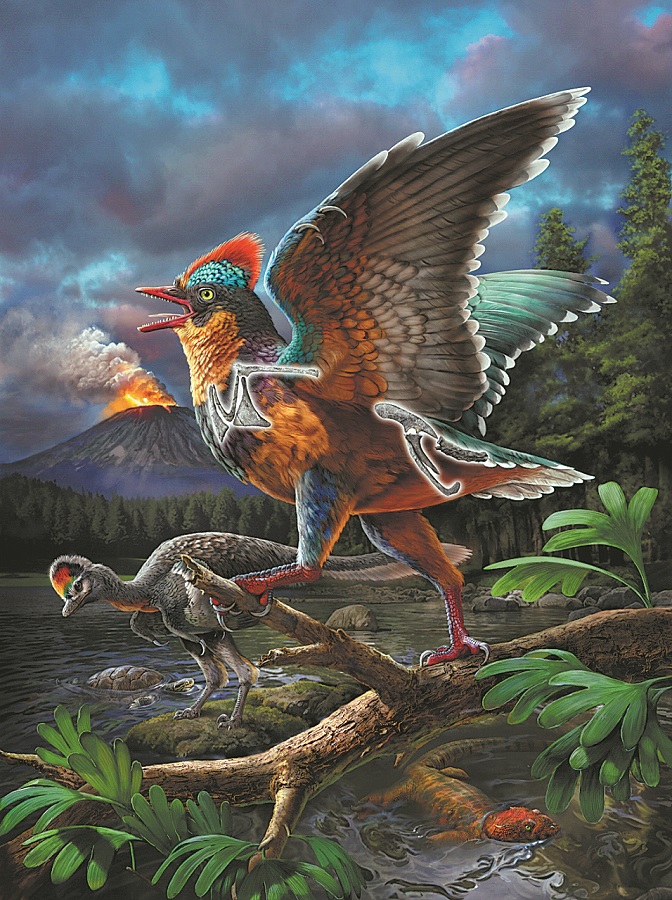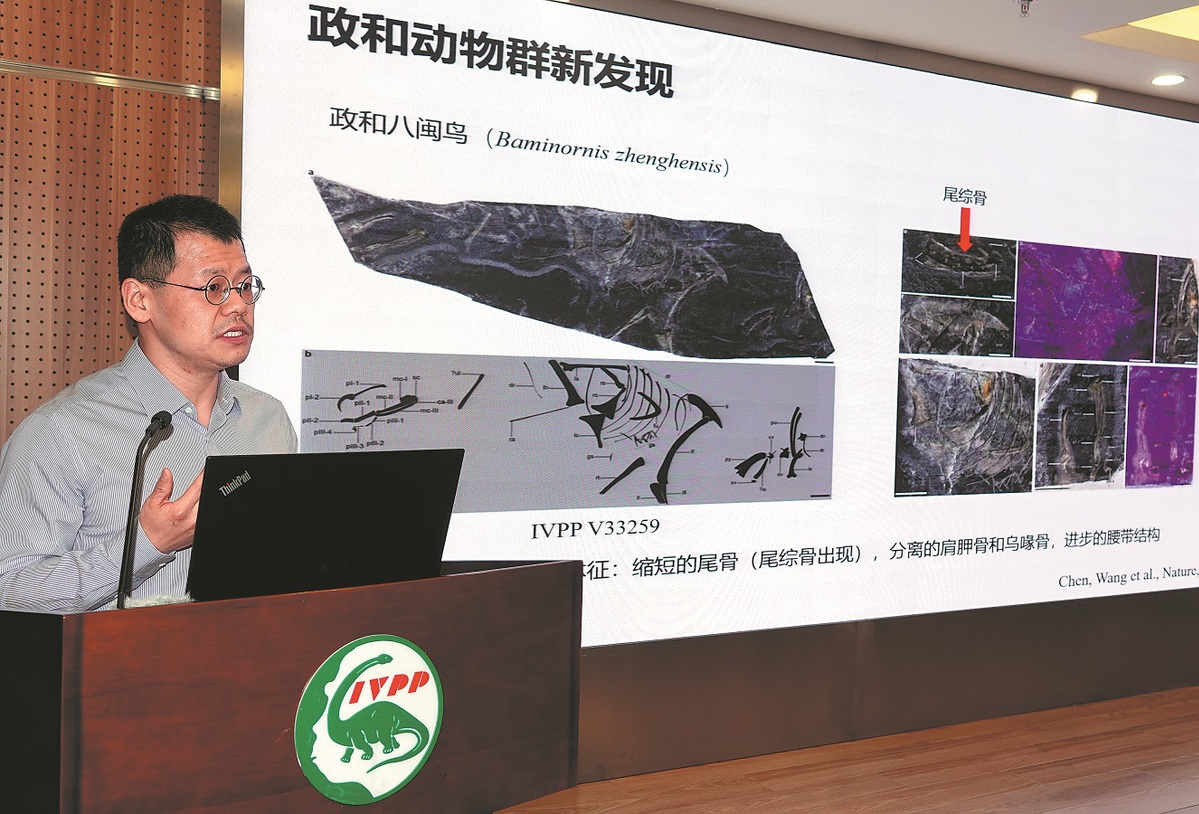
An illustration shows the reconstructed image of the Jurassic bird species named Baminornis zhenghensis. XINHUA
A set of fossils discovered in East China's Fujian province has been identified as the only known unambiguous record of Jurassic birds, pushing back the origin of birds to the late Middle Jurassic period and rewriting the history of avian evolution.
After a year of restoration and research, a joint team from the Institute of Vertebrate Paleontology and Paleoanthropology of the Chinese Academy of Sciences and the Fujian Institute of Geological Survey confirmed that the set of fossils discovered in November 2023 in Daxi village of Fujian's Zhenghe county belong to a bird from the late Middle Jurassic period, dating back approximately 150 million years.
In their study, which was published in Nature journal on Thursday, the researchers named the bird species Baminornis zhenghensis. Its fossils display a unique combination of features including birdlike shoulder and pelvic girdles as well as a hand structure resembling that of nonavian dinosaurs, according to the CAS.
"Birds evolved from dinosaurs, which is one of the most astonishing chapters in the history of evolution. This process involved significant changes in bones, muscles and other biological structures, representing a leap from land to sky," said Xu Xing, an academician of the CAS and director of its paleontology institute.
"The Zhenghe Fauna, where the set of fossils was found, offers a rare glimpse into the ecosystems of the late Mesozoic era. It's a treasure trove for understanding the origins of the variety of life we see today," he added.

Wang Min, a researcher at the Chinese Academy of Sciences' Institute of Vertebrate Paleontology and Paleoanthropology, speaks on Monday in Beijing during a presentation on bird fossils found in Jurassic-era rocks. SUN ZIFA/CHINA NEWS SERVICE
Since 2021, researcher Wang Min and academician Zhou Zhonghe from the CAS institute have collaborated with the Fujian Institute of Geological Survey to form a field team and conduct systematic fossil studies and geological research in the province.
In September 2023, the team reported in Nature the first discovery of skeletal fossils of a dinosaur in Fujian, naming the species Fujianvenator prodigiosus and the fossil assemblage the "Zhenghe Fauna".
Zhou said the discovery provided a new window into the evolution of life on land in East Asia during the late Mesozoic era.
The area of the fossil assemblage, characterized by swamps and wetlands, was home to a diverse array of species of fish, amphibians and reptiles, among others. In November 2023, the field team discovered two incomplete reptilian fossils in the Zhenghe Fauna. At first glance, Zhou and Wang speculated that the fossils belonged to a bird.
"After systematic research and comparison, the hypothesis was confirmed. The restored bird weighed over 150 grams, similar to a domesticated pet parrot," said Wang.
Macroevolutionary studies previously speculated that the diversification of birds began in the Jurassic period, but this hypothesis lacked fossil evidence.
One of the most significant differences between birds and reptiles is in their tails. Avian species have shorter tails with fewer tail vertebrae, and the last few vertebrae are fused into a structure called the pygostyle. This adaptation is crucial for shifting the body's center of gravity forward, enabling independent movement of the hind limbs and tail and refining flight capabilities.
"The shortening of the tailbone was one of the most profound changes in body structure during the transition of dinosaurs into birds. What makes the Baminornis unique is that it has a short tail that consists of the pygostyle, which is a key feature of the modern bird body plan," Wang said.
The Archaeopteryx, the fossils of which were first discovered around 1860, belonged to the Late Jurassic period and was once considered the earliest bird. However, its long tail and primitive features led some scientists to question its classification as a bird. Instead, they suggested that it belonged to a group of bird-like dinosaurs.
"The Archaeopteryx was identified as a bird over 160 years ago because of its feather fossils. At that time, feathers were considered exclusive to birds," said Zhou. "But with advances in fossil research, this single-trait classification is outdated. Modern classification relies on studying evolutionary relationships, and we now know that some dinosaurs also had feathers."
The Archaeopteryx and other "suspected Jurassic birds" retained long tailbones similar to dinosaurs, making them significantly different from birds in terms of skeletal structure.
Whether birds truly existed during the Jurassic period remained a mystery until now. The discovery of the Baminornis confirms for the first time that the skeletal structure of modern birds had already appeared during the Jurassic period, 20 million years earlier than previously thought.
In addition to the Baminornis fossils, the research team also discovered a separately preserved furcula, a forked bone found in most birds.
Analysis showed that the furcula closely resembles those found in derived birds called the ornithuromorphs from the Cretaceous period — the earliest of which appeared 130 million years ago — and is distinctly different from the Baminornis and other Jurassic birds and dinosaurs.
The discovery of this furcula confirms that at least two species of birds lived in the Zhenghe Fauna. If the furcula indeed belongs to the ornithuromorpha, the origin of birds would be pushed back even further.
Stephen L. Brusatte, from the School of GeoSciences at the University of Edinburgh in the United Kingdom, said, "The Baminornis is a landmark discovery and ranks among the most important bird fossils unearthed since the discovery of the Archaeopteryx in the early 1860s."